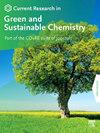利用废旧饮料纸盒回收纸浆和生物基聚乳酸制作一次性吸油垫
Q2 Materials Science
Current Research in Green and Sustainable Chemistry
Pub Date : 2025-01-01
DOI:10.1016/j.crgsc.2025.100486
引用次数: 0
摘要
牛奶、果汁和其他饮料消费量的增加导致了饮料纸盒残留废物的增加。研究了以饮料纸盒再生纸浆为芯层,以无纺布聚乳酸(PLA)为面层的吸油垫材料。回收纸浆经不同纺纱时间研磨,可制成粗浆、中浆和超细浆。这些纸浆分别用JAN(日本)和GER(德国)硅烷溶液处理,浓度分别为1、2、3、5和10 wt%。采用熔喷法制备了无纺布聚乳酸,螺杆转速分别为0.5和13 rpm,得到了大型和超细聚乳酸垫。对再生纸浆与无纺布PLA的重量比(100:0 ~ 0:100)进行吸油试验。未经处理的超细纸浆虽然不能自行成片,但其吸收能力最高,达到19.5 g/g。未处理的纸浆始终比处理过的纸浆吸收更多的油。因此,使用未经处理的超细纸浆与PLA混合比例进行进一步测试。结果表明,随着PLA含量的增加,吸油性降低。在聚乳酸样品中,大尺寸的无纺布聚乳酸吸收容量最高,为19.8 g/g,被选择用于垫面层。最终吸油垫的尺寸为10 cm × 10 cm,采用超声波焊接的方法对各层进行密封。开发的原型采用了可回收和可生物降解的材料,为吸油应用提供了符合环境目标的可持续解决方案。本文章由计算机程序翻译,如有差异,请以英文原文为准。
Utilization of recycled pulp from used beverage cartons and bio-based PLA for disposable oil-absorbing pads
The increasing consumption of milk, juice, and other beverages has led to a rise in residual waste from beverage cartons. This study focuses on developing oil-absorbing pads using recycled pulp from beverage cartons as the core layer and non-woven polylactic acid (PLA) as the face layer. Recycled pulp was ground at various spinning times, producing rough, intermediate, and ultrafine forms. These pulps were treated with JAN (Japan) and GER (Germany) silane solutions at concentrations of 1, 2, 3, 5, and 10 wt%. Non-woven PLA was fabricated via the melt-blown process at screw speeds of 0.5 and 13 rpm, resulting in large and ultrafine PLA mats. Oil absorbency tests were conducted at various weight ratios of recycled pulp to non-woven PLA (100:0 to 0:100). Although untreated ultrafine pulp was unable to form sheets on its own, it exhibited the highest absorption capacity, reaching up to 19.5 g/g. Untreated pulp consistently absorbed more oil than treated variants. Consequently, ultrafine untreated pulp was used for further testing in mixed ratios with PLA. The results showed a decrease in oil absorbency with increasing PLA content. Among the PLA samples, the large non-woven PLA achieved the highest absorption capacity of 19.8 g/g and was selected for the pad's face layer. The final oil-absorbing pads, sized 10 cm × 10 cm, were fabricated using ultrasonic welding to seal the layers. The developed prototype incorporates recycled and biodegradable materials, offering a sustainable solution for oil absorption applications aligned with environmental goals.
求助全文
通过发布文献求助,成功后即可免费获取论文全文。
去求助
来源期刊

Current Research in Green and Sustainable Chemistry
Materials Science-Materials Chemistry
CiteScore
11.20
自引率
0.00%
发文量
116
审稿时长
78 days
 求助内容:
求助内容: 应助结果提醒方式:
应助结果提醒方式:


